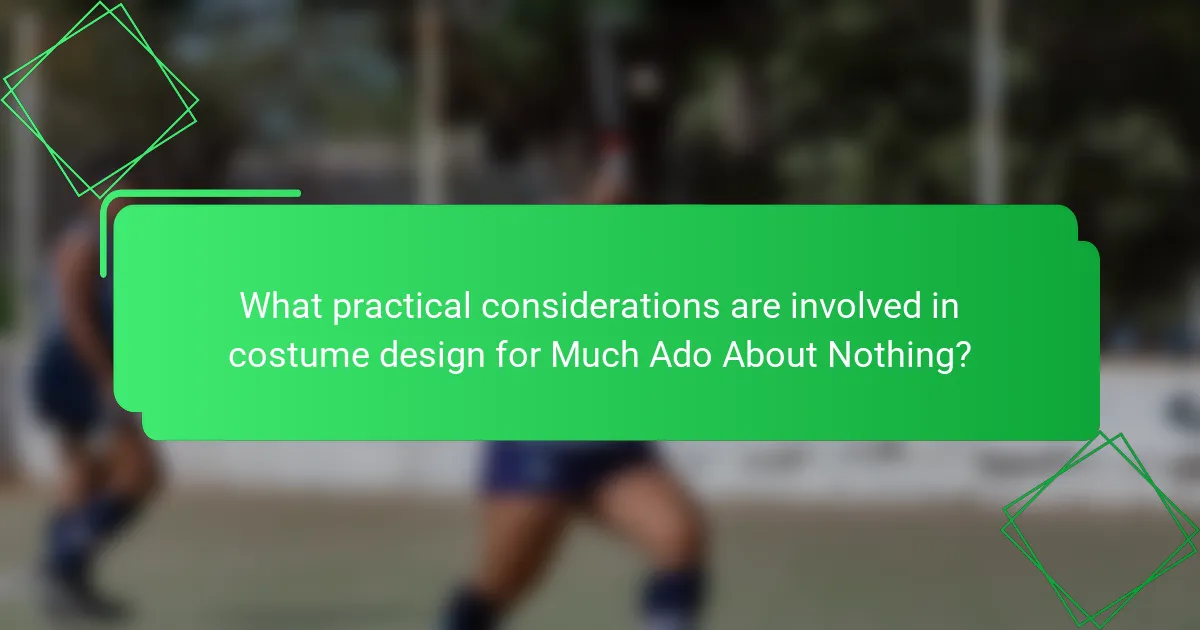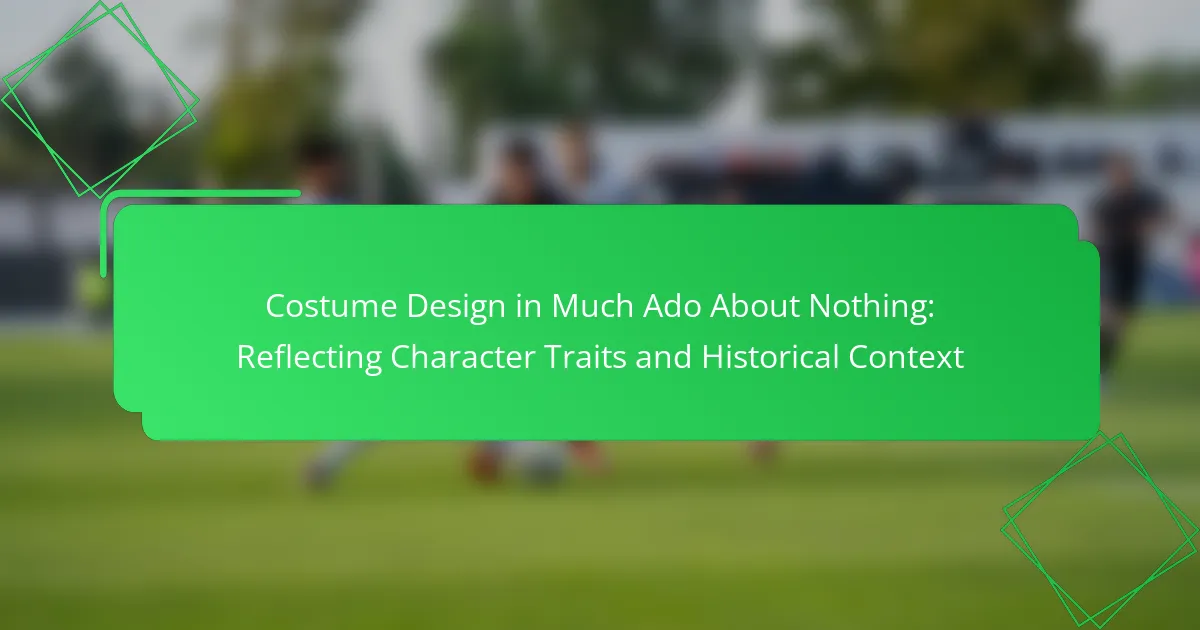
What is the role of costume design in Much Ado About Nothing?
Costume design in Much Ado About Nothing serves to reflect character traits and historical context. Costumes visually communicate the social status and personality of each character. For instance, the elaborate attire of characters like Don Pedro signifies nobility. In contrast, simpler outfits worn by lower-status characters highlight their roles. The design also enhances the comedic and dramatic elements of the play. Bright colors and styles can indicate mood shifts or thematic elements. Historical accuracy in costumes connects the audience to the Elizabethan era. Overall, costume design is integral in conveying deeper meanings within the narrative.
How does costume design reflect character traits in the play?
Costume design in the play reflects character traits through visual symbolism and color choices. For instance, characters like Beatrice wear vibrant, bold colors that signify their strong and independent personalities. In contrast, Hero’s softer, muted tones represent her more demure and traditional nature. The materials used also convey social status; higher-class characters often wear luxurious fabrics, highlighting their wealth and power. Additionally, costumes can indicate character development; for example, Claudio’s darker attire during moments of conflict reflects his inner turmoil. Historical context further influences these designs, as they often mirror the societal norms of the era. Overall, costume design serves as a crucial tool for understanding character dynamics and traits within the narrative.
What specific costumes are associated with key characters?
Key characters in “Much Ado About Nothing” are associated with distinct costumes that reflect their traits. For example, Beatrice often wears vibrant, fashionable dresses that signify her strong personality and independence. Benedick typically dons tailored outfits that convey his status and charm. Claudio’s costumes are more subdued, reflecting his romantic and sometimes insecure nature. Hero’s attire is elegant and modest, symbolizing her innocence and virtue. Don Pedro wears regal garments that emphasize his noble status and leadership. These costume choices align with the characters’ roles and relationships, enhancing the play’s themes and historical context.
How do color and fabric choices convey personality?
Color and fabric choices convey personality by reflecting emotional states and social status. Bright colors often signify confidence and vibrancy, while darker shades can indicate seriousness or introspection. Fabrics like silk suggest luxury and sophistication, whereas rough textures may imply practicality or ruggedness. Historical context shows that specific colors were associated with certain classes; for example, purple was reserved for royalty. Studies indicate that individuals often choose clothing colors that align with their mood and self-image. This connection between attire and personality is evident in character portrayals in costume design, such as in “Much Ado About Nothing.” In this play, characters’ costumes visually communicate their traits and relationships, enhancing audience understanding.
In what ways does costume design enhance the historical context of the play?
Costume design enhances the historical context of the play by visually representing the era’s social norms and values. It provides insight into the characters’ status and roles within society. For example, costumes can indicate wealth through fabric choice and embellishments. Specific historical attire reflects the time period, such as the Elizabethan era in “Much Ado About Nothing.” This contextual accuracy helps the audience understand the setting and characters better. Additionally, costumes can symbolize broader themes like honor and reputation, prevalent in the play’s narrative. By aligning visual elements with historical details, costume design deepens the audience’s immersion in the story.
What historical fashion influences are evident in the costumes?
The costumes in “Much Ado About Nothing” reflect historical fashion influences from the Elizabethan era. This period is characterized by intricate designs and rich fabrics. Costumes often feature high collars, ruffs, and elaborate sleeves. The use of velvet and silk was prevalent among the upper class. Additionally, the color palette includes deep hues, symbolizing wealth and status. Accessories such as hats and jewelry were common, enhancing the overall look. Historical records indicate that these styles were meant to convey character traits and social hierarchy. Thus, the costumes serve as a visual representation of the time’s fashion trends.
How do costumes represent societal norms and values of the era?
Costumes represent societal norms and values of the era by visually reflecting the cultural, social, and economic conditions of the time. They depict class distinctions through fabric choice and style, showcasing wealth or poverty. For instance, in the Elizabethan era, the use of luxurious materials like silk indicated higher social status. Costumes also convey gender roles, with women’s clothing emphasizing modesty and femininity, while men’s attire often highlights power and authority. Historical context reveals that specific colors and patterns were associated with particular social classes. For example, bright colors were reserved for the wealthy, while the lower classes wore muted tones. Additionally, costumes can illustrate moral values, such as chastity or honor, influencing character portrayal in literature and theater. In “Much Ado About Nothing,” characters’ costumes reflect their societal roles and relationships, reinforcing the play’s themes of love and deception.

How do the costumes contribute to the overall themes of the play?
Costumes in “Much Ado About Nothing” enhance the play’s themes of identity and social status. They visually represent character traits, such as the contrast between Beatrice’s bold attire and Hero’s more subdued garments. This distinction emphasizes the theme of societal expectations versus personal desires. Costumes also signify the characters’ relationships and transformations throughout the play. For example, the shift in clothing during the masquerade scene highlights themes of deception and misunderstanding. Historical context informs the costume choices, reflecting the Elizabethan era’s class structures. Overall, costumes serve as a powerful tool for illustrating the play’s core themes.
What themes are highlighted through character costumes?
Character costumes in “Much Ado About Nothing” highlight themes of social status, identity, and deception. Costumes visually represent the characters’ roles and societal positions. For example, noble characters wear elaborate attire, reflecting their wealth and status. In contrast, lower-status characters wear simpler clothing, emphasizing their social standing. The use of masks during the masquerade ball symbolizes deception and hidden identities. This theme of appearance versus reality is prevalent throughout the play. Additionally, costumes can reflect personal transformation, as characters change their attire to signify shifts in their identities or intentions. Overall, character costumes serve as a critical tool for conveying these themes effectively.
How do costumes symbolize love and deception?
Costumes symbolize love and deception by visually representing characters’ intentions and emotions. In “Much Ado About Nothing,” costumes reflect societal roles and personal identities. For example, characters in elegant attire often convey romantic intentions, while disguises indicate deceit. The use of masks or altered clothing can create confusion and misinterpretation. This is evident when characters conceal their true feelings or identities through their clothing choices. Historical context reveals that costumes were essential in conveying social status and relationships in the Elizabethan era. The interplay of love and deception is highlighted through the contrasts in costume design, reinforcing the narrative’s themes.
What role does costume play in the comedic elements of the story?
Costume plays a crucial role in the comedic elements of the story. In “Much Ado About Nothing,” costumes enhance humor through visual gags and character contrasts. For instance, the mismatched attire of characters often highlights their social status and personality traits. This visual disparity can create comedic misunderstandings. Additionally, disguises and mistaken identities are central to the plot. These costume changes lead to humorous situations and dialogue. The use of costumes reflects the characters’ intentions and foibles, amplifying the comedic effect. Overall, costumes serve as a tool for both character development and comedic storytelling.
How do different productions interpret costume design?
Different productions interpret costume design through various historical contexts and character representations. Each production may choose costumes that reflect the time period of the play or adapt them to modern settings. For instance, traditional interpretations often use Elizabethan attire to enhance authenticity. Conversely, contemporary adaptations might utilize modern clothing to connect with current audiences. The choice of colors, fabrics, and styles can also signify character traits. For example, vibrant colors may represent youthful energy, while darker tones might indicate seriousness or conflict. Productions often collaborate with costume designers to ensure that visual elements align with the overall vision. This collaboration results in unique interpretations that can vary significantly between performances.
What variations exist in costume design across different adaptations?
Variations in costume design across different adaptations of “Much Ado About Nothing” reflect diverse historical contexts and character interpretations. Each adaptation may emphasize different time periods, leading to unique clothing styles. For instance, a modern adaptation might use contemporary fashion to resonate with current audiences. Conversely, a period adaptation could showcase Elizabethan attire, highlighting historical accuracy. Costume choices also vary based on character traits; for example, Beatrice may be portrayed in bold colors to reflect her strong personality. In contrast, Hero’s costumes might be softer and more traditional, symbolizing her innocence. Additionally, adaptations may utilize accessories and fabric choices to convey social status or thematic elements. Overall, costume design variations enhance storytelling by visually representing character dynamics and contextual backgrounds.
How do directors use costumes to convey their vision of the play?
Directors use costumes to convey their vision of the play by visually representing characters’ traits and themes. Costumes help establish the time period and social status of characters. For instance, in “Much Ado About Nothing,” costumes can reflect the characters’ personalities and relationships. Bright colors may indicate a character’s vibrancy, while darker tones can suggest complexity or conflict. Historical accuracy in costume design also grounds the play in its setting. This approach enhances audience understanding and engagement with the narrative. Ultimately, costumes serve as a vital tool for directors to communicate their artistic interpretation of the play.

What practical considerations are involved in costume design for Much Ado About Nothing?
Costume design for Much Ado About Nothing involves several practical considerations. Designers must consider the historical context of the play, which is set in the late 16th century. This period influences fabric choices, colors, and styles to ensure authenticity. Character traits also guide costume decisions; for instance, Beatrice’s attire may reflect her strong-willed nature while Hero’s may emphasize her innocence. Budget constraints impact material selection and the complexity of designs. Additionally, the functionality of costumes is crucial for actors’ movement and comfort during performances. Collaboration with directors and actors ensures that costumes align with the overall vision of the production. Effective communication and research are necessary to create costumes that enhance storytelling and character development.
What are the key factors to consider when designing costumes for the play?
Key factors to consider when designing costumes for a play include character alignment, historical accuracy, and visual storytelling. Character alignment ensures costumes reflect the personalities and traits of each character. Historical accuracy involves researching the time period to create authentic attire. Visual storytelling focuses on how costumes convey themes and emotions to the audience. Additionally, practicality is essential for actors’ movement and comfort. Budget constraints also influence material choices and design complexity. Finally, collaboration with the director ensures the costume design aligns with the overall vision of the production.
How does budget impact costume design choices?
Budget directly impacts costume design choices by limiting the materials and resources available. A lower budget often results in simpler designs and fewer costume changes. Designers may opt for less expensive fabrics and accessories. This can affect the overall visual quality and authenticity of the costumes. Conversely, a larger budget allows for intricate designs and higher-quality materials. It enables more elaborate costumes that can enhance character portrayal. Historical context also plays a role; period-accurate costumes may require more investment. Ultimately, budget influences both creativity and practicality in costume design.
What materials are most suitable for period-accurate costumes?
Wool, linen, and silk are the most suitable materials for period-accurate costumes. Wool was commonly used for outer garments due to its warmth and durability. Linen, made from flax, was favored for its breathability and comfort in warmer climates. Silk, though more expensive, was often used for formal attire and indicated wealth. Historical evidence shows that these materials were prevalent in the clothing of the era depicted in Much Ado About Nothing. For instance, records from the Elizabethan period highlight the use of these fabrics in both everyday wear and nobility’s clothing.
What tips can be applied for effective costume design in productions?
Effective costume design in productions requires a deep understanding of the characters and historical context. Research the time period to ensure authenticity in fabric and style. Collaborate closely with directors to align costumes with the overall vision. Utilize color psychology to convey character traits and emotions. Create sketches to visualize designs before production begins. Consider the practicality of costumes for actors’ movements. Ensure costumes reflect character development throughout the narrative. Finally, gather feedback during fittings to make necessary adjustments. These tips enhance the storytelling aspect of the production through visual representation.
How can designers balance authenticity with audience engagement?
Designers can balance authenticity with audience engagement by integrating historical accuracy with relatable elements. Authenticity involves accurately reflecting the time period and character traits in costume design. Designers must research historical costumes to ensure accurate representation. Simultaneously, they should consider contemporary audience preferences and cultural references. For instance, incorporating modern fabrics or styles can make costumes more appealing. Engaging audiences can also involve using color schemes that resonate with current trends. This approach invites viewers to connect with the characters on a personal level. Ultimately, a successful balance enhances the storytelling experience while respecting historical context.
What are common challenges faced in costume design for this play?
Common challenges faced in costume design for “Much Ado About Nothing” include historical accuracy and character representation. Designers must ensure costumes reflect the Elizabethan era while being functional for actors. Balancing authenticity with modern audience expectations is difficult. Budget constraints often limit fabric choices and design options. Additionally, the need for quick costume changes can complicate design logistics. Understanding character traits is essential for conveying personality through attire. Collaboration with directors and actors is necessary to align vision and execution. Each of these factors contributes to the complexity of costume design for the play.
Costume design in Much Ado About Nothing serves as a vital tool for reflecting character traits and historical context. The article explores how costumes visually communicate social status, personality, and emotional states, highlighting specific attire associated with key characters. It discusses the influence of color and fabric choices on character representation and how costume design enhances the play’s themes of identity, love, and deception. Additionally, the article examines practical considerations in costume design, including historical accuracy, budget constraints, and the balance between authenticity and audience engagement.


